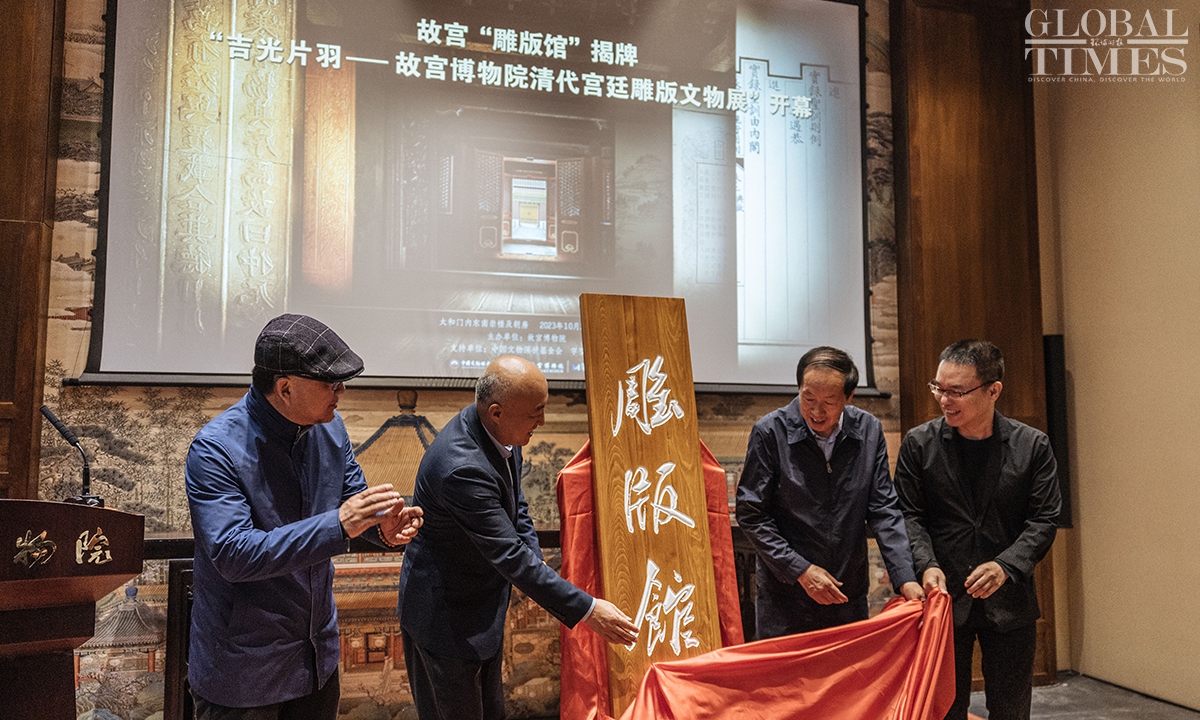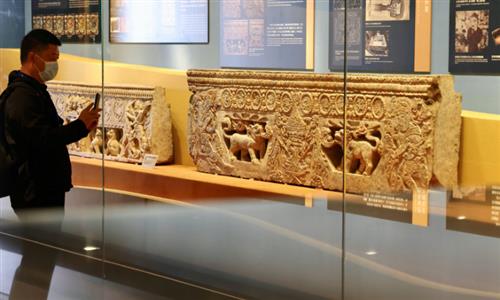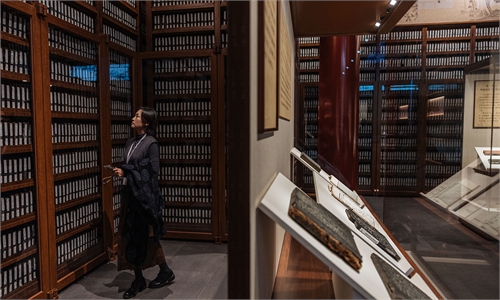ARTS / CULTURE & LEISURE
Exhibition ‘achievement’ in research of engravings: curator
Palace Museum artifacts highlight great invention

Photo: Li Hao/GT
The Palace Museum in Beijing launched a new Engravings Hall on Tuesday, which for the first time systematically showcases the protection and academic research achievements of one of ancient China's Four Great Inventions - woodblock printing.
Invented by Chinese craftsmen, this ancient printing technique propelled human civilization to mass produce printed works during the Tang Dynasty (618-907), a time when Buddhism prevailed in China.
On Monday, the Palace Museum said that the establishment of the new hall was partly in response to a set of guidelines on stepping up the preservation and publication of ancient books published by Chinese authorities in April 2022. The guidelines emphasize efforts such as protection, research, publication and digitization.
Opening day also witnessed the launch of a new exhibition, A Glimpse of Splendor - The Palace Museum's Collection of Qing Dynasty Palace Woodblock Printing Artifacts, which displays more than 15,000 artifacts.
Among them, 32 representative artifacts are highlighted and explained in terms of state governance, culture, education and craftsmanship, leading visitors to appreciate the charm of this ancient Chinese engraving art.
Calling the exhibition greatly significant, Palace Museum curator Wang Xudong said on Monday that it was an achievement in the sorting and research of engravings, especially those from the Qing Dynasty (1644-1911) collected by the museum.
Wang noted that the museum "sets the Qing palace engravings against the big picture of Chinese history, printing history, and Qing palace history, and excavates the historical information contained in the engraving artifacts, showing their special role in philology."
Gao Rong, deputy curator of the Yangzhou Museum, which has a great number of ancient engraved woodblocks in its collection, told the Global Times on Tuesday that the Palace Museum exhibition reflects a comprehensive effort to organize, research, and deeply explore the value of woodblock printing.
"It is a great encouragement for our ongoing efforts in the field of woodblock printing as we will hold related events for promoting woodblock culture with the participation of South Korea, Japan and Vietnam this November," Gao said.
"China's traditional woodcut printing techniques are the crystallization of the wisdom of ancient Chinese laborers. Its invention promoted cultural communication and information sharing, and greatly advanced world civilization," Beijing-based historian Wang Xisen told the Global Times, adding that the techniques not only spread widely in China, but also reached other Asian countries such as Japan, Korea and Vietnam, as well as Europe and Africa through the Silk Road, playing an important role in world culture.
"Woodblock printing reached its peak during the Ming (1368-1644] and Qing dynasties, a period when many precious historical documents, classic works, folk literature and artworks were preserved through this technique, providing rich academic materials and cultural heritage for later generations," said the historian.
According to the museum, this large cultural institution not only has a complete set of classic books and related engraving archives printed by the Qing palace, but also more than 200,000 engravings.
The collections span from the Ming Dynasty to the late Qing Dynasty, covering classic literature, history and government documents in four languages - Chinese, Manchu, Mongolian and Tibetan.
The exhibition displays engravings, archives and other literature, providing important written evidence that gives insight into engraving during the Qing Dynasty.
The engraving Prince Regent's Order from the first year of the Shunzhi Emperor's reign (1644) and Records of Imperial Academy, printed by the Imperial Academy in the 14th year of Emperor Daoguang's reign (1834), are among the displays.
Wang Pei, deputy director of the National Ancient Books Protection and Conservation Center, told the Global Times on Tuesday that ancient woodblock prints are the foundation of ancient texts and share a close ancestral relationship with them. Just like rare editions of ancient texts, they are precious cultural artifacts. However, over time, many woodblocks have been lost due to environmental factors such as fire and floods, or human actions such as war. As a result, they are exceedingly rare, making their preservation and protection all the more valuable.
Ancient woodblocks are of significant importance for verifying various versions of classic texts. In ancient times, verification of ancient texts relied heavily on textual comparison, but it was difficult to detect any changes, corrections, or supplements using this method. The existence of these engraved woodblocks provides the most direct and reliable basis for verifying different versions.



